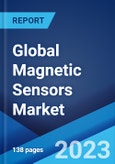The global magnetic sensors market size reached US$ 3.9 Billion in 2022. Looking forward, the market is expected to reach US$ 6.1 Billion by 2028, exhibiting a growth rate (CAGR) of 7.74% during 2022-2028.
Magnetic sensors are used to detect the magnitude of magnetism and geomagnetism produced by a magnet or current. They are widely available in several types with unique features. For instance, coils are the simplest magnetic sensors that can detect changes in the magnetic flux density. Moreover, miniature magnetic sensors are gaining traction across the globe for advanced intelligent measurement and control systems. At present, several manufacturers are introducing magnetic sensors with high precision for industrial applications, such as inverters and drives or battery management.
Magnetic sensors are used to detect the magnitude of magnetism and geomagnetism produced by a magnet or current. They are widely available in several types with unique features. For instance, coils are the simplest magnetic sensors that can detect changes in the magnetic flux density. Moreover, miniature magnetic sensors are gaining traction across the globe for advanced intelligent measurement and control systems. At present, several manufacturers are introducing magnetic sensors with high precision for industrial applications, such as inverters and drives or battery management.
Magnetic Sensors Market Trends
Magnetic sensors offer advantages, such as allowing contactless and wear-free measurement of mechanical quantities like the angle of rotation and speed. As they are robust and economical, the escalating demand for vehicles across the globe represents one of the significant factors driving the adoption of magnetic sensors in the automotive industry. In addition, with the advent of giant magnetoresistance (GMR) thin-film systems, manufacturers are focusing on developing a new generation of magnetic sensors that provides advantages, including large working distances and precise angular position measurement. Apart from this, magnetic sensors are being widely utilized in the military field to detect vehicles or other events in monitored areas. The rising crime rates and cross-border security issues are also bolstering the market growth. Moreover, the growing prevalence of medical conditions is influencing the usage of magnetic field sensors in the biomedical sector for manufacturing point-of-care (POC) devices. Furthermore, magnetoelectric (ME) composites with high coefficients can be utilized to make sensitive magnetic field sensors for next-generation multifunctional devices. Such advancements are anticipated to expand the applications of magnetic sensors in robotics, space equipment, and industrial measurements worldwide.Key Market Segmentation
This research provides an analysis of the key trends in each sub-segment of the global magnetic sensors market report, along with forecasts at the global, regional and country level from 2023-2028. The report has categorized the market based on technology, application and end use.Breakup by Technology:
- Hall Effect Sensor
- Magnetoresistive Sensor
- Squid Sensor
- Fluxgate Sensor
Breakup by Application:
- Speed Sensing
- Detection
- Position Sensing
- Navigation
Breakup by End Use:
- Aerospace and Defense
- Automotive
- Consumer Electronics
- Healthcare
Breakup by Region:
- North America
- United States
- Canada
- Asia-Pacific
- China
- Japan
- India
- South Korea
- Australia
- Indonesia
- Europe
- Germany
- France
- United Kingdom
- Italy
- Spain
- Russia
- Latin America
- Brazil
- Mexico
- Middle East and Africa
Competitive Landscape
The competitive landscape of the industry has also been examined along with the profiles of the key players being Amphenol Corporation, Analog Devices Inc., Asahi Kasei Microdevices Corporation (Asahi Kasei Corporation), Honeywell International Inc., Infineon Technologies AG, NXP semiconductors N.V., Schneider Electric, ST Microelectronics, TDK Corporation, TE Connectivity and Texas Instruments Incorporated.Key Questions Answered in This Report:
- How has the global magnetic sensors market performed so far and how will it perform in the coming years?
- What has been the impact of COVID-19 on the global magnetic sensors market?
- What are the key regional markets?
- What is the breakup of the market based on the technology?
- What is the breakup of the market based on the application?
- What is the breakup of the market based on the end use?
- What are the various stages in the value chain of the industry?
- What are the key driving factors and challenges in the industry?
- What is the structure of the global magnetic sensors market and who are the key players?
- What is the degree of competition in the industry?
Table of Contents
1 Preface3 Executive Summary11 Value Chain Analysis13 Price Analysis
2 Scope and Methodology
4 Introduction
5 Global Magnetic Sensors Market
6 Market Breakup by Technology
7 Market Breakup by Application
8 Market Breakup by End Use
9 Market Breakup by Region
10 SWOT Analysis
12 Porters Five Forces Analysis
14 Competitive Landscape
Companies Mentioned
- Amphenol Corporation
- Analog Devices Inc.
- Asahi Kasei Microdevices Corporation (Asahi Kasei Corporation)
- Honeywell International Inc.
- Infineon Technologies AG
- NXP semiconductors N.V.
- Schneider Electric
- ST Microelectronics
- TDK Corporation
- TE Connectivity
- Texas Instruments Incorporated
Methodology

LOADING...
Table Information
| Report Attribute | Details |
|---|---|
| No. of Pages | 138 |
| Published | November 2023 |
| Forecast Period | 2022 - 2028 |
| Estimated Market Value ( USD | $ 3.9 Billion |
| Forecasted Market Value ( USD | $ 6.1 Billion |
| Compound Annual Growth Rate | 7.7% |
| Regions Covered | Global |
| No. of Companies Mentioned | 11 |









